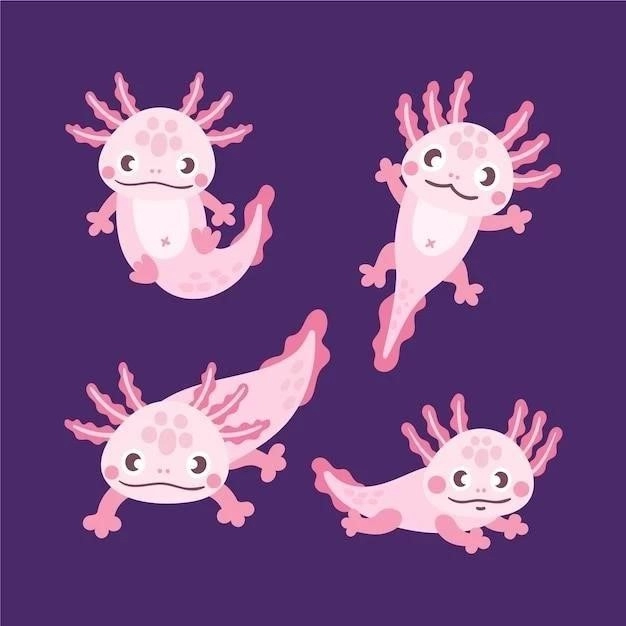The Axolotl: An Overview
The axolotl (Ambystoma mexicanum), also known as the Mexican walking fish, is a captivating amphibian renowned for its unique characteristics and regenerative abilities. Native to the freshwater lakes of Mexico, this permanently aquatic salamander has captivated scientists and hobbyists alike.
Origin, History, and Physical Characteristics

The axolotl, scientifically known as Ambystoma mexicanum, boasts a rich history intertwined with the ancient Aztec civilization of Mexico. Revered for its unique characteristics, the axolotl derives its name from Xolotl, the Aztec god of fire and lightning, symbolizing its profound connection to their culture. These fascinating creatures were first discovered thousands of years ago in the freshwater lakes of Xochimilco and Chalco, where they were an integral part of the ecosystem.
Distinguished by its neotenous nature, the axolotl retains its larval features throughout its life, unlike other salamander species that undergo metamorphosis. This remarkable characteristic is evident in their external gills, which resemble delicate, feathery appendages protruding from the back of their heads. These gills, along with their slender bodies and long, laterally compressed tails, contribute to their perpetually aquatic existence.

Axolotls typically reach lengths of 6 to 18 inches, with their physical appearance further characterized by lidless eyes, wide heads, and underdeveloped limbs. They possess four slender legs, each terminating in long, thin fingers, which they use for maneuvering through their aquatic environment. Their coloration varies, with wild-type axolotls typically exhibiting a dark brown or black base color speckled with gold or olive-green markings. However, selective breeding in captivity has led to a wide array of color variations, known as morphs, including leucistic, albino, golden albino, and melanoid, among others.
Unique Biology and Regeneration Abilities
What truly sets the axolotl apart from other amphibians is its astonishing capacity for regeneration. While many amphibians can regenerate limbs to some degree, the axolotl’s regenerative prowess is unparalleled. They can regenerate not only limbs but also various other body parts, including their tails, spinal cords, heart tissue, and even portions of their brains, with remarkable fidelity and functionality. This extraordinary ability has positioned the axolotl as a focal point for scientific research, particularly in the fields of regenerative medicine and developmental biology.
The axolotl’s regenerative process is a complex interplay of cellular and molecular mechanisms that remain an active area of scientific investigation. Upon injury, the axolotl’s wound healing response is rapid, preventing scarring and facilitating the formation of a structure called a blastema. This blastema is a mass of undifferentiated cells that possesses the remarkable ability to develop into the various cell types required to replace the missing or damaged tissue. Researchers believe that understanding the molecular signals and cellular pathways governing this process could hold significant implications for developing novel therapeutic approaches to tissue regeneration in humans.
Furthermore, the axolotl’s neotenous nature, retaining larval characteristics throughout its life, contributes to its remarkable regenerative abilities. Unlike most salamanders that undergo metamorphosis, axolotls retain their larval cells, which are believed to play a crucial role in their regenerative prowess. These cells, known as stem cells, possess the unique ability to differentiate into various cell types, enabling the axolotl to regrow complex tissues and organs with remarkable accuracy.

Creating the Perfect Axolotl Habitat
Creating a comfortable and safe habitat is crucial for the well-being of your axolotl. These sensitive amphibians thrive in a well-maintained, species-appropriate environment that caters to their unique needs.
Tank Setup: Size, Filter, and Substrate

Providing an appropriately sized aquarium is paramount to ensuring your axolotl’s well-being. A single adult axolotl requires a minimum tank size of 20 gallons, with an additional 10 gallons recommended for each additional axolotl. Opting for a larger tank is always advisable, as it provides more stable water parameters and allows for ample swimming space.

Filtration is essential for maintaining optimal water quality in your axolotl’s habitat. Axolotls are messy eaters and produce a significant amount of waste, necessitating an efficient filtration system to remove harmful toxins. Sponge filters and hang-on-back filters are excellent choices for axolotl tanks, as they provide both mechanical and biological filtration while minimizing water flow. Avoid filters that generate strong currents, as axolotls prefer still or slow-moving water.
Selecting the appropriate substrate is crucial for your axolotl’s safety and well-being. While bare-bottom tanks are an option, a fine sand substrate is generally preferred. Fine sand, with a grain size of 1mm or less, allows axolotls to grip and move comfortably without the risk of ingestion or impaction. Avoid gravel or substrates with larger particles, as these can pose a significant health hazard to your axolotl.
Lighting, Plants, and Decorations
Axolotls are sensitive to light due to their underdeveloped eyelids. In their natural habitat, they inhabit the dimly lit depths of lakes, so replicating these conditions in captivity is essential. While they do not require bright lighting, providing a low-light environment is crucial for their well-being. Ambient room lighting is generally sufficient; however, if you choose to incorporate artificial lighting, opt for low-wattage LED lights with a dimmable feature.
Live plants are a beneficial addition to any axolotl habitat. They not only enhance the aesthetic appeal of the aquarium but also provide numerous benefits for your axolotl. Live plants contribute to a healthy ecosystem by absorbing nitrates and providing oxygenation. Additionally, they offer hiding places and visual enrichment for your axolotl. When selecting plants, choose hardy, low-light species such as Java fern, Anubias, and Java moss. Avoid plants with sharp edges or those known to be toxic to amphibians.
Decorations, such as caves, rocks, and driftwood, can further enrich your axolotl’s environment, providing hiding spots, visual barriers, and opportunities for exploration. When selecting decorations, ensure they are smooth, free of sharp edges, and made from aquarium-safe materials. Avoid decorations with small, loose parts that could be ingested by your axolotl. It is essential to create a visually stimulating and naturalistic environment for your axolotl, providing them with a sense of security and well-being.

Essential Axolotl Care
Providing proper care is essential for the health and longevity of your axolotl. These captivating amphibians require specific water parameters, a nutritious diet, and regular maintenance to thrive in captivity.
Water Parameters and Temperature Control
Maintaining optimal water parameters is crucial for the health and well-being of axolotls. These amphibians are highly sensitive to changes in water chemistry, and even slight deviations from the ideal range can lead to stress, illness, or even death. Regular water testing and maintenance are essential for ensuring a healthy aquatic environment for your axolotl.
The ideal temperature range for axolotls is between 60-68°F (15-20°C). They are cold-water amphibians, and temperatures above 72°F (22°C) can cause stress, suppress their immune system, and lead to health problems. A reliable aquarium thermometer and, if necessary, a cooling system, such as a fan or aquarium chiller, are essential for maintaining a stable and appropriate water temperature. Avoid sudden temperature fluctuations, as these can shock and harm your axolotl.
Axolotls thrive in water with a pH between 7.4 and 7.6. Maintaining a stable pH within this range ensures their respiratory and metabolic processes function optimally. Regular water changes and the use of a pH buffer, if necessary, can help maintain a stable pH level. It is essential to monitor the pH regularly, especially after water changes or the addition of new decorations or plants, to ensure it remains within the acceptable range.
Feeding and Maintenance
Axolotls are carnivorous amphibians with a hearty appetite. Providing them with a varied and nutritious diet is essential for their overall health and well-being. Axolotls should be fed a diet that closely resembles their natural food sources, consisting primarily of protein-rich foods.
Earthworms are an excellent staple food for axolotls, providing a rich source of protein and essential nutrients. Other suitable food options include bloodworms, blackworms, brine shrimp, and commercially available axolotl pellets. Avoid feeding your axolotl feeder fish, as these can introduce parasites or diseases into their environment. It is also essential to remove any uneaten food promptly to maintain optimal water quality.
Regular water changes are crucial for maintaining a healthy aquatic environment for your axolotl. Perform a 20% water change weekly using a siphon or gravel vacuum to remove accumulated waste and debris from the substrate. When adding new water, ensure it is dechlorinated and at the same temperature as the aquarium water to avoid shocking your axolotl. It is also advisable to test the water parameters regularly using an aquarium test kit to monitor the levels of ammonia, nitrite, nitrate, and pH.











